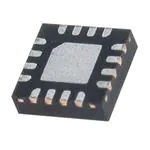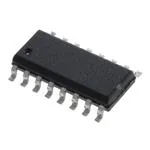ES9038PRO DAC & AK4499 Comparison | Datasheet & Review
- Type: -
- Output Type: -
- Polarity: -
- Package: -

FREE delivery for orders over HK$250.00

Quick response, quick quotaton

Flash shipment,no worries after sales

Original channel,guarantee of the authentic products
es9038pro
If you’re looking to build truly high-end audio gear, this flagship DAC chip from ESS is exactly what you need. It’s a premium 32-bit Hi-Fi audio decoder used widely in audiophile-grade products, delivering amazingly clear and detailed sound thanks to an incredible 140 dB dynamic range. Its distortion levels are incredibly low—down to -122 dB—meaning you’ll hear your music just as intended, without unwanted noise.
You can easily handle ultra-high-res audio with PCM signals up to 768 kHz (32-bit) and native DSD512 support. It has eight DAC channels, giving you options for multi-channel setups or improving stereo performance by combining channels. ESS’s HyperStream® II technology ensures precise timing and significantly reduces jitter, further enhancing sound quality.
The built-in volume control keeps your circuit simple while preserving top-notch audio quality, and you can choose from seven digital filters to customize your sound. It’s packaged in a convenient 128-pin LQFP package, ideal for compact, high-end audio gear, whether it’s a professional recording studio, audiophile headphone amps, or your ultimate home theater system.
es9038pro pinout configuration

| Pin Number | Pin Name | Description |
|---|---|---|
| 1 | MCLK | Main clock input (up to 100 MHz) |
| 2 | DATA_CLK | PCM/DSD data bit clock input |
| 3 | DATA1 | PCM frame clock input (LRCK) |
| 4–7 | DATA2–DATA5 | PCM serial data input (supports multi-channel) |
| 8–15 | DATA6–DATA13 | SPDIF input (configurable multi-channel SPDIF input) |
| 16–23 | DATA1–DATA8 | DSD data input channel |
| 24–31 | DAC1–DAC8 | Analog current output channels (each channel independent) |
| 32–39 | DACB1–DACB8 | Analog current output channels (for differential output) |
| 40 | AVCC_L | Analog power supply input for left audio channel (Recommended 3.3V) |
| 41 | AVCC_R | Analog power supply input for right audio channel (Recommended 3.3V) |
| 42 | DVCC_L | Digital core power supply input for left audio channel (Recommended 1.2V) |
| 43 | DVCC_R | Digital core power supply input for right audio channel (Recommended 1.2V) |
| 44 | DGND | Digital Ground |
| 45 | AGND | Analog Ground |
| 46 | SDA | I²C data line |
| 47 | SCL | I²C clock line |
| 48 | RESETB | Reset pin (Active low) |
| 49–52 | GPIO1–GPIO4 | General-purpose I/O (Configurable for multiple functions) |
| 53 | ADDR | I²C address selection pin |
| 54 | XI | External crystal oscillator input |
| 55 | XO | External crystal oscillator output |
When you’re working with the ES9038PRO DAC, there are a few things you should keep in mind to get the absolute best audio performance. First, give it stable, clean power—typically 3.3V for analog (AVCC) and 1.2V for digital (DVCC). Using a low-noise power supply will really make your sound stand out. The main clock input (MCLK) is also critical; choose a crystal or clock source with very low jitter to keep your audio crystal-clear.
Make sure you properly configure your GPIO pins through the chip’s registers—they can handle SPDIF input, MCLK output, and more, depending on your setup. Remember, the DAC outputs a current signal, so you’ll need an external I/V conversion circuit, usually using a high-quality op-amp, plus proper filtering.
For tweaking chip settings like input sources, volume, and filters, you’ll need reliable I²C communication from your controller. Finally, don’t overlook heat management; the ES9038PRO can run warm at high performance, so add adequate heat dissipation on your PCB—like wider copper areas or heat sinks—to keep it running smoothly.
es9038pro equivalent dac chip

| Parameter | ES9038PRO | AK4499EQ | ES9028PRO | ES9038Q2M |
|---|---|---|---|---|
| Manufacturer | ESS Technology | Asahi Kasei Microdevices | ESS Technology | ESS Technology |
| Number of Channels | 8 | 4 | 8 | 2 |
| Dynamic Range (DNR) | 140 dB | 140 dB | 129 dB | 129 dB |
| Total Harmonic Distortion + Noise (THD+N) | -122 dB | -124 dB | -120 dB | -120 dB |
| Max Supported PCM Sampling Rate | 768 kHz / 32-bit | 768 kHz / 32-bit | 768 kHz / 32-bit | 768 kHz / 32-bit |
| Max Supported DSD Format | DSD512 | DSD512 | DSD512 | DSD512 |
| Package Type | 128-pin LQFP | 128-pin LQFP | 64-pin LQFP | 32-pin QFN |
| Application Scenarios | High-end multi-channel audio systems | High-end home theater and multi-channel audio systems | High-performance audio equipment | Portable and embedded audio equipment |
| Power Supply Voltage | 3.3V (Analog), 1.2V (Digital) | 5V (Analog), 3.3V (Digital) | 3.3V (Analog), 1.2V (Digital) | 3.3V (Analog), 1.2V (Digital) |
| Programmable Filters | Yes | Yes | Yes | Yes |
| Volume Control | Digital volume control | Digital volume control | Digital volume control | Digital volume control |
When you’re looking at swapping an ES9038PRO with an AK4499EQ, here’s what you should keep in mind. Both chips use the same 128-pin LQFP package, so physically fitting them isn’t usually a problem. Still, carefully check each pin’s function to avoid unexpected issues.
Performance-wise, AK4499EQ offers slightly better THD+N specs, but both chips have similar dynamic ranges, so pick based on your project needs. Pay attention to their power differences too—AK4499EQ needs 5V for analog and 3.3V for digital, while ES9038PRO requires just 3.3V analog and 1.2V digital. You’ll need to adjust your power circuit accordingly.
Also, think about the channels you need. The ES9038PRO gives you eight channels, great for multi-channel setups, whereas AK4499EQ has four, ideal for premium stereo setups. Lastly, if you prefer extremely detailed sound, ESS chips like ES9038PRO might suit you better, whereas AKM chips offer a warmer, more natural tone.
es9038pro dac circuit schematic

When you’re building your audio circuit with the ES9038PRO DAC, keep in mind that its outputs are differential current signals (DAC+ and DAC-), both sitting at a common-mode voltage of about 1.2V. You’ll typically convert these currents into usable voltage signals using a pair of high-quality op-amps (like U1 and U3). These two op-amps take the differential signals and feed balanced audio outputs through resistors into XLR connectors, great for pro-level gear because they’re noise-resistant.
If you need a single-ended RCA output for traditional audio systems, you’ll add another op-amp (U2) to combine the balanced signals into a clean single-ended line. Use precision resistors—1% metal film or better—to keep your audio clean and balanced. Also, carefully manage common-mode voltage differences to ensure there’s no DC offset. Finally, lay out your PCB thoughtfully, keeping analog paths short and isolating analog grounds from digital to minimize noise.
es9038pro diy dac audio project
When you’re designing an audio circuit around the ES9038PRO DAC, the power supply is your number one priority. Use separate, ultra-low-noise supplies for analog (3.3V) and digital sections (1.2V), ideally a regulator like LT3042, and combine quality electrolytic capacitors (like Nichicon FG or Muse) with film caps to reduce noise.
For your clock circuit, choose a low-phase-noise crystal such as the Crystek CCHD-575 (100 MHz), and carefully route the traces to minimize interference. Make sure your digital inputs—USB (via XMOS or Amanero boards), SPDIF, and I²S—are properly impedance-matched and have solid ESD protection.
In your analog output stage, pick premium op-amps like OPA1612 or AD797 for converting the DAC’s current output into clean voltage signals. Include a low-pass filter with a cutoff above 50kHz to remove unwanted noise.
Finally, keep analog and digital grounds separate, connecting them at just one point. Place sensitive parts like crystals and the DAC chip away from noisy power circuits, and keep analog traces short and direct to preserve audio quality.
es9038pro usb dac wiring guide
When you’re setting up your USB DAC based on the ES9038PRO, remember it doesn’t directly accept USB inputs. You’ll need a USB audio interface—like XMOS or Amanero—to handle USB signals and translate them into I²S for the DAC. Then, your DAC will turn these digital signals into analog audio. For optimal performance, power the digital part at 1.2V and the analog part at 3.3V, using low-noise regulators. Also, choose a precision clock, like Crystek’s CCHD-575, to minimize jitter and enhance audio clarity. For the output stage, use high-quality op-amps such as OPA1612 or AD797 to convert the DAC’s differential current outputs into a clean voltage signal. Make sure your PCB separates analog and digital grounds, connecting them at only one spot. After assembling, test all voltages carefully and ensure no unwanted DC offset appears on outputs. Finally, hook it up, play your favorite tracks, and check the clarity and stereo balance thoroughly.
es9038pro balanced output circuit

When you’re setting up your audio circuit with the ES9038PRO DAC, here’s what you need to know. First, your chip outputs audio as differential current signals (L_COLD and L_HOT). You’ll convert these currents into usable voltage signals with an op-amp like the OPA1612. Use quality feedback resistors and small compensation capacitors to keep noise and distortion low.
After the initial conversion, use a low-pass filter—built from carefully chosen resistors and capacitors—to clean out any unwanted high-frequency noise. Next, an op-amp such as the OPA1611 combines and buffers the signals, creating a stable, balanced output perfect for connecting via XLR.
Pay close attention to your op-amp’s power lines. Put plenty of decoupling capacitors nearby to keep voltage stable and noise-free. Choose precision-matched resistors (ideally 1% or even 0.1%) to ensure perfect signal balance. Finally, when laying out your PCB, keep analog sections away from noisy digital areas, and keep your differential lines short and equal in length.
es9038pro dac power supply design
When you’re designing the power supply for your ES9038PRO DAC setup, clean and stable power is absolutely crucial for achieving top-notch sound quality. You’ll want separate supplies for the analog (3.3V), digital (1.2V), and clock circuits (usually 3.3V or 5V). For the digital rail, choose ultra-low-noise regulators like LT3042 or ADM7150, and pair them with high-quality ceramic and film capacitors to minimize noise. For analog power, it’s best to use dedicated low-noise regulators like LT3045 or TPS7A4700 along with premium audio capacitors from Nichicon or Panasonic to keep your sound crystal clear. The clock section deserves its own power line too, preventing jitter and interference—again, TPS7A4700 works great. When laying out your PCB, separate analog and digital grounds and connect them at a single point near the DAC chip to avoid noise. Finally, always double-check voltage stability with an oscilloscope and fine-tune your component choices through careful listening tests.








